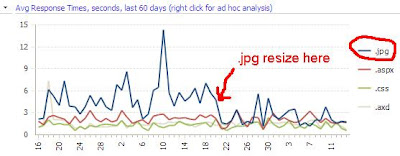My internet site (http://richardlees.com.au/) is hosted on Sharepoint Server 2007.  There are many photos on my site, particularly, but not exclusively, family snaps. In SharePoint I have resized the photos for easier display. I knew that SharePoint did not physically resize the images, but didn't appreciate the full impact it had on people browsing my site over a low speed link. Since SharePoint did not physically resize the photo (.jpg file) a 2MB file might be downloaded to show a little photo whose image only needs to be a few kilobytes. I am a bit disappointed that Sharepoint doesn't resize images automatically. I kind of feel that since it knows how big the display images are, it could resize them accordingly, and even though it didn't do it now, I thought it must be fixed in a service
There are many photos on my site, particularly, but not exclusively, family snaps. In SharePoint I have resized the photos for easier display. I knew that SharePoint did not physically resize the images, but didn't appreciate the full impact it had on people browsing my site over a low speed link. Since SharePoint did not physically resize the photo (.jpg file) a 2MB file might be downloaded to show a little photo whose image only needs to be a few kilobytes. I am a bit disappointed that Sharepoint doesn't resize images automatically. I kind of feel that since it knows how big the display images are, it could resize them accordingly, and even though it didn't do it now, I thought it must be fixed in a service  pack or subsequent release.
pack or subsequent release.
 There are many photos on my site, particularly, but not exclusively, family snaps. In SharePoint I have resized the photos for easier display. I knew that SharePoint did not physically resize the images, but didn't appreciate the full impact it had on people browsing my site over a low speed link. Since SharePoint did not physically resize the photo (.jpg file) a 2MB file might be downloaded to show a little photo whose image only needs to be a few kilobytes. I am a bit disappointed that Sharepoint doesn't resize images automatically. I kind of feel that since it knows how big the display images are, it could resize them accordingly, and even though it didn't do it now, I thought it must be fixed in a service
There are many photos on my site, particularly, but not exclusively, family snaps. In SharePoint I have resized the photos for easier display. I knew that SharePoint did not physically resize the images, but didn't appreciate the full impact it had on people browsing my site over a low speed link. Since SharePoint did not physically resize the photo (.jpg file) a 2MB file might be downloaded to show a little photo whose image only needs to be a few kilobytes. I am a bit disappointed that Sharepoint doesn't resize images automatically. I kind of feel that since it knows how big the display images are, it could resize them accordingly, and even though it didn't do it now, I thought it must be fixed in a service  pack or subsequent release.
pack or subsequent release.Anyway a couple of weeks ago a partner colleague mentioned to me his frustration with these images, so I spent a few minutes and resized all the .jpg images in SharePoint. I was only using about 30 images, so it only took about 30 minutes. It is interesting how much difference this has made to the performance of my web site. The home page on my web dashboard shows average response times for the major file types (.aspx, .axd, .css, and .jpg) over the last 60 days. If you look at this graph (top right on http://RichardLees.com.au/Sites/Demonstrations) you will see .jpg has dropped in response time around May 21. Althought there is quite a lot of daily variations since it is an average of many different size images. I haven't had such a large performance change since I talked to my son about his download activity (http://richardlees.blogspot.com/2009/01/is-my-web-site-getting-slower.html).
You are able to drill into the response time graph, and even take it to a new window if you know how to drive PerformancePoint (see http://richardlees.blogspot.com/2009/04/try-out-microsofts-zero-footprint-cube.html for some quick instructions). I have done this, and drilled down to the photo of Anna and myself on unicycles (one of the main MB culprits). The graph is attached. You can achieve the same, although you will see a more up to date chart since the cube is updating every few minutes.
Two takeaways from this initiative.
- If you are using SharePoint 2007, it pays to resize your images to the display size.
- It always pays to monitor and log performance of any production application so that you can see user performance and the impact of your tuning exercises
For more close to real-time performance information of my internet site and the two servers behind the site goto http://RichardLees.com.au/Sites/Demonstrations

No comments:
Post a Comment